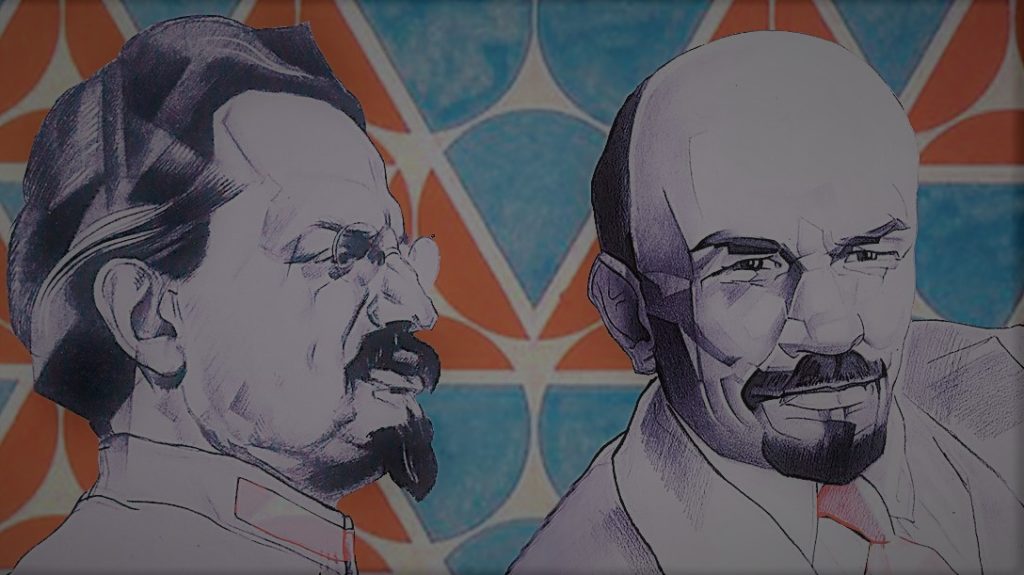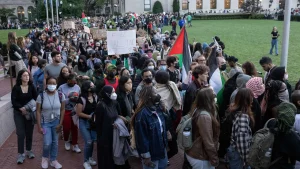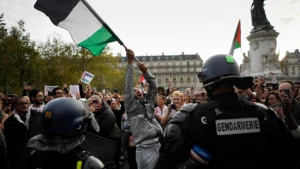Several libraries could be filled with the debates on how revolutionaries should organize themselves and what role the party should play. The generation of revolutionaries at the beginning of the 20th century had to face these problems at a time when imperialism was forever changing the relationship between the workers’ movement and revolutionary organizations, ending the era of “mass” workers’ parties, understood as groupings that would fulfill the role of organizing the “disorganized masses” and reflecting the growth and self-recognition of the working class — as in the model of German social democracy in the period of capitalist expansion. Crises, world wars, and revolutions have since brought these issues into sharp focus, not only making the debate on strategy tenser but also allowing alternatives to be tested in practice.
Trotsky in particular, who in his first years in the Russian social democratic party criticized Lenin’s ideas about the party and who only joined the Bolshevik Party between the two revolutions of 1917, had to address the debate on party formation after Lenin’s death in the light of a phenomenon Marxism had not previously encountered: the bureaucratization of the first workers’ state in history and of the party that had led to the triumph of that revolution. The policies necessary for constructing revolutionary parties in the various countries where the Left Opposition was active, and later the formation of a new international organization, were the focus of his letters, pamphlets, and formulations throughout the 1930s. It was around that time that Trotsky elaborated some of his best-known and most comprehensive theories on these problems, as in The History of the Russian Revolution, The Revolution Betrayed, and his writings on France and Spain, which we have analyzed in several publications of our current. Here we outline some notes on less familiar writings that deal with the topic.
Masses and Party
Throughout his autobiography, My Life (1929), Trotsky offers simple and brief descriptions of the Bolshevik Party’s different moments and of Lenin’s various fights to forge what we would call a “Leninist party.” This is probably because the book was written in the midst of Stalinist attacks aimed at pushing a new conception of “Leninism” that would serve to justify the zigzags of the regime’s politics and do away with the old Bolshevik guard. Just as with its retouching and outright elimination of people from photos, it was something Stalinism needed in order to put an end to what was revolutionary in that tradition.
These descriptions often make their points by subtly counterposing a vignette to the broader revolutionary objective. For instance, Trotsky describes the party and revolution in the 1905 period as “still young at that time, and one was struck by the inexperience and lack of finish revealed both by the members and by their actions in general.” But “long years of laborious gathering of forces, of political training, of theoretical analysis and experience” — while it may not have transformed one young comrade he mentions — built up the revolutionaries overall.1Leon Trotsky, My Life, chap. 13, “The Return to Russia.”
Trotsky’s other text refers to the experience of the formation of the Bolshevik party, the organization that,
as it developed and hardened, advanced and retreated, became more and more closely bound to the masses of workers, set before them ever more far-reaching tasks, and fifteen years later overthrew the bourgeoisie and assumed power.2Ibid., chap. 10, “My First Escape.”
The first of these quotations gives an account of the process of forging the program, strategy, and party cadres in a reactionary period after a defeat. The second is the relationship these cadres and this policy had with the masses they would soon lead.
These are not evolutionary stages. The development of theory and program, strategic discussions, and the formation of cadres certainly do not take place outside the experiences of the workers’ movement and its struggles. The practice of gaining influence in sectors of the workers’ movement is not exempt from ideological and theoretical debate, or from new political lessons from the class struggle in which the party must continue to educate itself. It is not a question of forging the program and then offering it to the masses. If there are any “stages,” they have more to do with the general context of the relationship of forces between the classes that may open or close the possibilities for developing a revolutionary party, something Lenin had already put forward against schematic visions and apparatuses that had turned some quotes from his What Is to Be Done? (1902) into absolutisms in the face of the emergence of the first soviets, united front organizations of the masses, in the 1905 revolution.
It was Lenin who, throughout What Is to Be Done?, outlined a notion of nonmechanical continuity between the class and the revolutionary party, which not only organized the class but also, as its vanguard detachment, delineated between a revolutionary strategy and the opportunistic strategies that appeared within his own Russian social democrat party — what we have called in another article the “Leninist innovation.” For Lenin, the party does not relate “to the masses” without some mediation. Workers are not an undifferentiated mass but a collective across which are found cultural differences, traditions, and above all — especially in the imperialist age — reactionary divisions provoked by the same bourgeoisie that seeks to introduce its politics into the workers’ movement. Therefore, the working class is not homogeneous from a political point of view, and in its bosom and institutions different strategies are contested and put into play. It is this conception that allowed the Bolsheviks to deploy their politics and finally win over the leadership of the soviets between the February and October revolutions of 1917. It was on the basis of these experiences that the defense of and struggle for the development of self-organization by the masses came to be so prominent in Trotsky’s conceptualization and in the Trotskyist currents.3For Trotsky, councils or soviets are also important after the seizure of power, insofar as they can be the basis for workers’ democracy in the new state, which we have characterized in other articles as “soviet multipartyism.” But that is not counterposed to the need to build a party, as claimed by autonomists and others who see in the fight for strategy mere divisiveness.
As Lenin and Trotsky saw it, the masses are not only defeated militarily but have often already been diverted or co-opted by their leaderships. The confrontation between revolution and counterrevolution involves previous battles that led to different relationships of established forces and different strategies tested and prepared earlier. For instance, the same European social democracy that Russian Marxism once saw as a model showed its worst face when it supported its national bourgeoisies in World War I, which led Lenin and Trotsky to form a new international.
Creating a revolutionary party cannot, therefore, take place through a gradual fattening up that at some point comes to represent the entire “class.” Rather, the party will have to seek out its own experiences, develop theory, and flesh itself out within a sector of the class so that through different gears — revitalized unions, coordinating committees, councils — it manages to win to its politics different sectors of the workers’ movement and other sectors of the exploited and oppressed. That is, the party must consciously seek to insert itself into the class and be part of its victories and defeats (drawing from these experiences the best possible conclusions). It must do this to have enough material forces ready to carry out its policies and win the right to lead the great mass “maneuvers” that will come along at moments of sharp turns in the class struggle.
Those on the current side of “economism” who defend a “nonparty” policy in the workers’ movement in pursuit of “unity” leave the field open for the development and influence of bourgeois politics, allowing the differences within the movement to deepen, confining workers to trade unionism, and denying them their character as political entities. Those who, for their part, insist on the political struggle but are unwilling to build it in the workers’ movement, instead only “speaking in its name,” such as in parliaments, do not go much further in this direction: they leave the field open for trade unionism, which they claim to fight for sooner rather than later, while educating their cadres and sympathizers in the same parliamentary logic, adapting to it by action or omission. Both strategies can be confronted and even coexist in the same organization, solidifying as a “division of labor” and united by respect for the existing bourgeois institutions (such was the case with German social democracy, divided between the parliamentary and union leaders, with neither serving as an alternative to the party’s reformist drift).
A revolutionary workers’ party, in the imperialist epoch, is a party of the advanced detachments of the working class, a party that seeks to use its politics to lead the mass sectors of the workers’ movement and, with a hegemonic policy, other exploited and oppressed sectors. This can be done only if it has sought to insert itself within the workers’ movement in a preparatory way, to win over fractions for its politics within the institutions in which workers are concentrated — the trade unions in particular — and in other sectors of potential allies, such as youth, the student movement, the women’s movement, and so on. Of course, such possibilities and the success of this policy will be relative to the situation of the class struggle more generally. It does not guarantee victory, but it is the only way to open up to its possibility.
Party and Marxist Theory
More than once, Trotsky surprised his peers by the apparent “futility” of opening theoretical discussions in the face of pressing circumstances. Several authors relate the astonishment of his comrades when, having just arrived in Mexico in the midst of the Stalinist persecution, the first thing he asked about was the study of paintings in that country and its level of sophistication.4See, for example, George Novack, Polemics in Marxist Philosophy (New York: Monad Press, 1980). Isaac Deutscher, a famous biographer of Trotsky, also refers to this conversation. See The Prophet Outcast (London: Oxford University Press, 1954). In several letters he exchanged with leaders of the Fourth International in the Socialist Workers Party, Trotsky made room to discuss and recommend the materials he considered necessary for the training of militants.5See, for example, “Philosophical Works” and “Interest in Dialectical Materialism” in Leon Trotsky, Works no. 40 (Paris: Leon Trotsky Institute, 1986). Subsequently, the discussions that culminated in a split in the Socialist Workers Party, the main section of the Fourth International, had as one of their axes the disdain for dialectics.6The debate can be found in Trotsky’s In Defense of Marxism and Their Morality and Ours. Given Trotsky’s circumstances at the time, these problems could be considered secondary, but debate and theoretical development were not for Trotsky simple accessories to party construction.
Revolutionary Marxists have in many cases appealed to a definition of theory as a “guide to action,” not in the sense of a political pragmatism that offers a theory for every action to be taken, nor an abstract theory in which historical novelties can be fitted. Theory will not be a place from which to take recipes applicable to every situation, but a development that can serve as a “bridge” between previous and future practice.
The definition of a bridge is Trotsky’s. This is how he set it down in a 1928 article in which he discusses the Stalinist caricature according to which “Leninism is the Marxism of the age of imperialism and proletarian revolution,” a way of justifying that the idea of “socialism in one country” was not a revision of Marxism but a “new stage” of it. Trotsky distinguishes Marxism both from idealism — particularly from a version of the “theory of factors” he attributes to Stalin — and from empiricism that cannot go beyond theory that “does not at all take shape in direct connection with the practical tasks of the day.”7Leon Trotsky, “Philosophical Tendencies of Bureaucratism,” December 1928.
Trotsky considers, instead, that historical materialism postulates the primacy of practice over theory, in the sense that it is in practice that theory is engendered and to it that he tries to generalize. But to point out the historical character of theory — concretely, the differences between the age of free exchange in which Marxist theory was forged and the imperialist stage that put on the agenda the proletarian revolution in which Lenin acted — could not mean it should be considered a mere reflection, in an empiricist sort of way, of the conditions in which the theory developed. The relationship between theory and practice cannot be considered in a linear manner:
To be guided by theory is to be guided by generalizations based on all the preceding practical experience of humanity in order to be able to cope as successfully as possible with one or another practical problem of the present day. Thus, through theory we discover precisely the primacy of practice-as-a-whole over particular aspects of practice.8Ibid.
What distinguishes the theory developed by Marx is not only that he analyzed the profound characteristics of the capitalist system, but also that he “anticipated” the era of proletarian revolution by formulating its possibilities. And in that sense as well, to train those who “are up to the practical tasks of the future”:9In the same sense, Lenin’s vilified claim that socialist ideas are “introduced from outside” into the workers’ movement can be understood. Lenin refers to the fact that the influence of bourgeois ideology and socialism take on different weights at different moments of the class struggle. In times of peace, given the predominant influence of the dominant ideology in the entirety of society and within the working class movement, socialist ideas are introduced “from outside” in the sense that they are not adopted immediately through one’s own experience but are mediated and obscured by that influence. This does not mean that the masses cannot break new ground — they certainly did so by creating the soviets — or be aware of their purpose, but that socialist ideas do not derive linearly from the economic struggle (let us remember that What Is to Be Done? was a polemic against economistic currents).
Theory, despite what Stalin says, does not take shape in inseparable connection with current practice. Not at all. It rises above it and only because of that has the capacity to direct tactics by indicating, in addition to the present tasks, points of orientation in the past and the perspectives for the future. … If Marxism, which arose in a prerevolutionary period, was by no means a “pre-revolutionary” theory but, on the contrary, rose above its own age to become the theory of proletarian revolution, then tactics — that is, the application of Marxism to specific combat conditions — by its very essence would rise above its own age, that is, the ripeness of the objective conditions. From the point of view of tactics — it would be more accurate to say, from the point of view of revolutionary strategy — the activity of Lenin differs in a colossal way from the activity of Marx and Marx’s earlier disciples, just as the age of Lenin differs from that of Marx.10Ibid.
Later in My Life, Trotsky defines in a few paragraphs what it was that allowed Lenin to build a revolutionary party in which the experience of the workers’ movement turned into theory and the deepest desires, demands, and energies of the masses were merged, allowing the theory to become, as Marx called it, “material force”:
And at such moments the highest theoretical consciousness of the epoch merges with the immediate action of those oppressed masses who are farthest away from theory. The creative union of the conscious with the unconscious is what one usually calls “inspiration.” Revolution is the inspired frenzy of history. … Besides other qualities, a great creative imagination was necessary to guide this work. One of the most valuable powers of such an imagination is the ability to visualize people, objects, and events as they really are, even if one has never seen them. To combine separate little strokes caught on the wing, to supplement them by means of unformulated laws of correspondence and likelihood, and in this way to recreate a certain sphere of human life in all its concrete reality, basing everything upon experience in life and upon theory that is the imagination that a legislator, an administrator, a leader must have, especially in a period of revolution. Lenin’s strength was chiefly this power of realistic imagination.11Leon Trotsky, My Life, chap. 20, “In Power.”
First published on August 18, 2019, in Spanish in Ideas de Izquierda.
Translation: Scott Cooper
Notes
| ↑1 | Leon Trotsky, My Life, chap. 13, “The Return to Russia.” |
|---|---|
| ↑2 | Ibid., chap. 10, “My First Escape.” |
| ↑3 | For Trotsky, councils or soviets are also important after the seizure of power, insofar as they can be the basis for workers’ democracy in the new state, which we have characterized in other articles as “soviet multipartyism.” |
| ↑4 | See, for example, George Novack, Polemics in Marxist Philosophy (New York: Monad Press, 1980). Isaac Deutscher, a famous biographer of Trotsky, also refers to this conversation. See The Prophet Outcast (London: Oxford University Press, 1954). |
| ↑5 | See, for example, “Philosophical Works” and “Interest in Dialectical Materialism” in Leon Trotsky, Works no. 40 (Paris: Leon Trotsky Institute, 1986). |
| ↑6 | The debate can be found in Trotsky’s In Defense of Marxism and Their Morality and Ours. |
| ↑7 | Leon Trotsky, “Philosophical Tendencies of Bureaucratism,” December 1928. |
| ↑8 | Ibid. |
| ↑9 | In the same sense, Lenin’s vilified claim that socialist ideas are “introduced from outside” into the workers’ movement can be understood. Lenin refers to the fact that the influence of bourgeois ideology and socialism take on different weights at different moments of the class struggle. In times of peace, given the predominant influence of the dominant ideology in the entirety of society and within the working class movement, socialist ideas are introduced “from outside” in the sense that they are not adopted immediately through one’s own experience but are mediated and obscured by that influence. This does not mean that the masses cannot break new ground — they certainly did so by creating the soviets — or be aware of their purpose, but that socialist ideas do not derive linearly from the economic struggle (let us remember that What Is to Be Done? was a polemic against economistic currents). |
| ↑10 | Ibid. |
| ↑11 | Leon Trotsky, My Life, chap. 20, “In Power.” |











